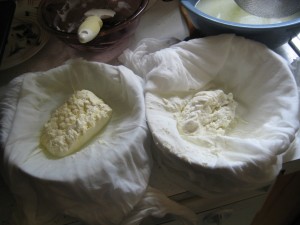August 30, 2008 at 3:07 pm
· Filed under amanda, education
I recently was turned on to David Fankhauser’s excellent cheese page. Mr. Fankhauser is a professor of Biology and Chemistry at the University of Cincinatti Clermont College. He has really dug into the science of cheesemaking and created a great resource for home cheesemakers. Check it out!
Permalink
August 30, 2008 at 8:21 am
· Filed under amanda, dairy
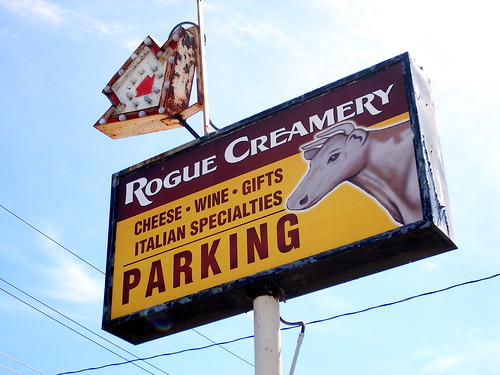
Thom and I did a weekend trip down to Southern Oregon, and stopped at the Rogue Creamery in Central Point. The Creamery has been making cheeses since the 1930s and is now very well-known for its blue cheeses, especially the Rogue River Blue which has won a number of awards and is wrapped in grape leaves and aged for 1 year.
Central Point is a small town in the Rogue River Valley in a part of Oregon that is generally sunnier and warmer than where we live in Portland. Along the Rogue River Valley Highway, also known as Highway 99 and known in Central Point as Front Street, is a very unassuming concrete building which houses the Creamery cheese shop and part of their manufacturing facility.
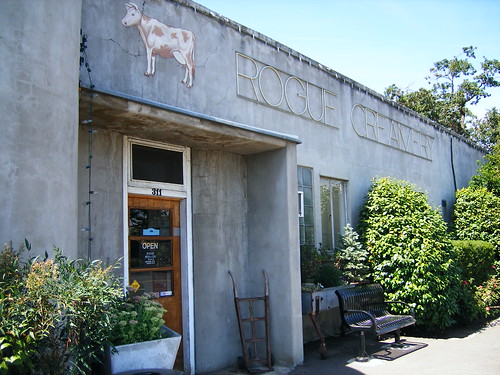
The cozy little cheese shop has samples of all their signature cheeses. I tried several of their cheddars, a few of their blues and also some of their flavored cheddars including lavendar, garlic and chocolate stout. I was really taken with that last one and we picked up some of that.
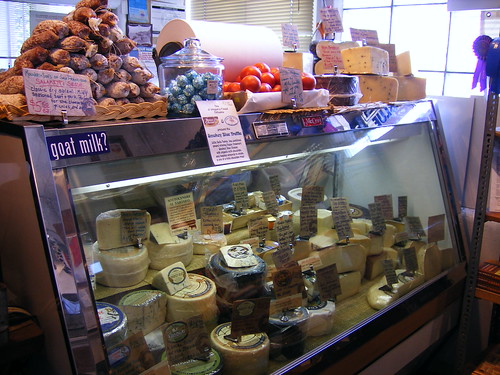
They also have a cheese case with cheeses from around the region and the very knowledgeable and friendly cheese ladies gave us samples of anything we wanted. From the cheese case we ended up selecting PondHopper, a cheese from Tumalo Farms in Bend which is a hard, aged goat cheese, unique for the hops that are added while steeping the curds. We also picked up Truffle Tremor from Cypress Grove, another goat cheese (I have a problem) — creamy and infused with the taste of truffles.
In looking at all the cheeses, chatting with the ladies, choosing some pear wine and some crackers and debating the merits of purchasing an insulated bag (we did), we totally forgot to swing back around and pick up some butter!
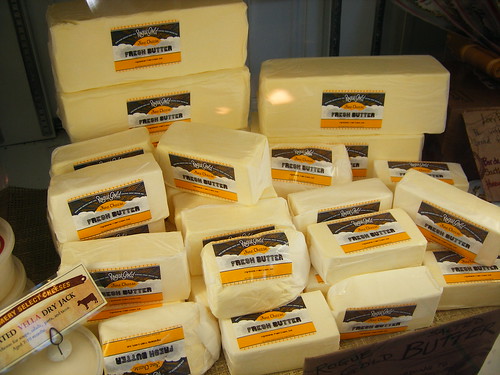
Doesn’t that look like the most wonderful butter in the whole world? I guess we’ll have to go back.
Check out a few more photos of the cheese shop on my flickr. You will find Rogue Creamery cheeses in reputable cheese shops all over Oregon, at Whole Foods, New Seasons, etc. and on their website which also has some great photos of their cheesemaking process.
Permalink
August 19, 2008 at 10:25 am
· Filed under amanda, goat, making, recipe
I almost forgot! In addition to the chevre and the fromage and the goat cheese and beer tasting, we also sampled some goat milk gelato (because I really don’t know when to stop). My mother-in-law got me the ice-cream maker attachment for the KitchenAid, which she also got me as a wedding gift way back. We share a love of delicious desserts!
I pasteurized the fresh goat’s milk and then followed this recipe from Alexandra’s Kitchen. I wish I had doubled the recipe because, unsurprisingly, 2 cups of goats milk makes about 2 cups of gelato. Though, if I had doubled that would have been 14 eggs! And, truly, the gelato was so rich and delicious and yummers that it’s probably a good thing we were limited.
The goat flavor in this was very subtle, overpowered by the rosemary, but the taste of rosemary in such a creamy concoction was really just over the top delicious, in my opinion. I love Alexandra’s beautiful plating of her gelato — after we did the beer/cheese tasting we all just grabbed spoons and dug in. This is the only photo we shot of it, almost gone:
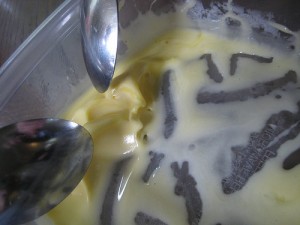
Permalink
August 18, 2008 at 1:54 pm
· Filed under cheese, cow, goat, making, nicole, recipe
Goat day was actually more of a goat weekend. Check out Amanda’s chevre posting for the first part of the saga. On Sunday a big group of us got together to experience the final results of the chevre process and to try our hand at some more instantaneous cheese - fromage blanc. I have to admit, I was most excited about this. Not that I don’t like chevre, I do, I love it, but ever since Sarah made a comment a while back about a toasted bagel smothered in fromage blanc I’ve been very excited to make this cheese.
There were numerous road blocks to this process, the primary issue being that apparently all really good cheeses require at least 36 hours to make. Upon reviewing the fromage blanc recipe from my cheese book and a few others on various websites it became clear that we didn’t have enough time in our afternoon of cheese making to do fromage blanc from beginning to end. So I opted to try out a recipe from the foodnetwork.com website that promised more immediate gratification. It was actually a very simple recipe, and as far as ingredients were concerned, all could be bought from your local grocery store (the lemon juice and buttermilk acting as the starter for the cheese).
We decided to try both a goat and a cow version of the fromage blanc so we did two half batches of this recipe. In the beginning the two batches acted and looked almost identical. We heated the milk over the stove once we had added the lemon juice & buttermilk mixture to the two pans. As the milk heated to 175 degrees the cow batch (likely due to the large amounts of cream in it) started getting a little thicker and turned a butter yellow color. After reaching 175 degrees we let the pans sit for 10 minutes and then hung the two batches up to drain in cheesecloth.
The final result was … good. They were also however, bland. They lacked the tang and somewhat cream cheese consistency I associate with fromage blanc. I think if we had not let them drain as long as we did that the consistency would have been more on target. I wish now however that we had started the fromage blanc on Saturday like we did the chevre, as I think that the longer versions of the recipe would have more of the tang and richness of flavor that I was looking for. As a quick way to try cheese making at home I would say this recipe was a great find, but for anyone looking to recreate a more authentic fromage blanc I would recommend you try another recipe.
You can view the pictures of the whole day and the fromage blanc making here.
Permalink
August 9, 2008 at 10:39 am
· Filed under amanda, beer, cheese, goat, tasting notes
Inspired by the New York Times article I wrote about previously, I started looking for some recommendations for cheese and beer pairings. We like beer near as much as we like cheese so it seemed only natural to put these two together. I came across a recommendation to pair summer beers like a wheat or hefeweizen with fresh young cheeses like chevre or fromage blanc. Since we had just made a batch of chevre that morning, I thought this would be perfect. Thom, my incredibly smart and handsome husband, who also happens to be a homebrewer and writer over at the BSBrewing Blog, came along to help me choose the beers.
Read the rest of this entry »
Permalink
August 3, 2008 at 8:39 am
· Filed under amanda, goat, making
For our third cheesemaking project, we wanted to make some goat cheeses. I had ordered the goat cheese kit from New England Cheesemaking Supply which came with four cheese molds, liquid rennet, chevre starter, fresh cheese starter, a yard of butter muslin and a recipe booklet. The first, easiest, recipe to make is the chevre.
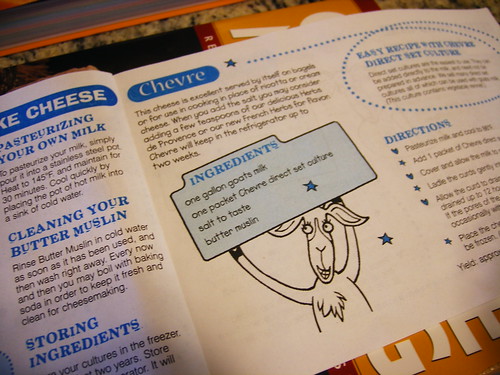
Â
We had gone out in the early morning and picked up the goats milk. We did a taste test of the fresh, unpasteurized goat milk and the milk was surprisingly light and not very “goaty” — it tasted almost like skim milk. As it was fresh it needed to first be pasteurized. For pasteurization, you need to keep the milk at 145 degrees for thirty minutes. Easier said than done. I think I need a better thermometer. It was pretty difficult to keep the milk at a constant temperature on my electric range.
After pasteurization, the recipe is very simple — add the chevre starter (a powder which comes in a little packet) and then you just have to wait. First the cheese needs to sit, uncovered and undisturbed for 12-20 hours or until firm and then you need to let it drain for another 6-12 hours. I let it set for about 9 hours until it kind of had a jello-like consistency. Since we wanted to eat it the next day, I needed to get it draining overnight. Next time, I’ll let it set for longer.
I was really surprised that the mixture had not separated into curds and whey but instead was still very mixed together. After making so many batches of mozzarella, I was just expecting something else. Here, I’m scooping the set chevre with my trusty “spoodle”:
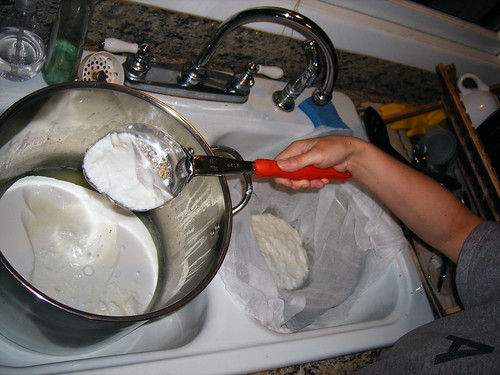
I then let it hang for about 12 hours and the result was a very creamy cheese with that wonderful chevre aroma. It was quite bland just tasting it out of the bag but with the addition of cheese salt and, later, herbs, it really came out quite divine.
Â
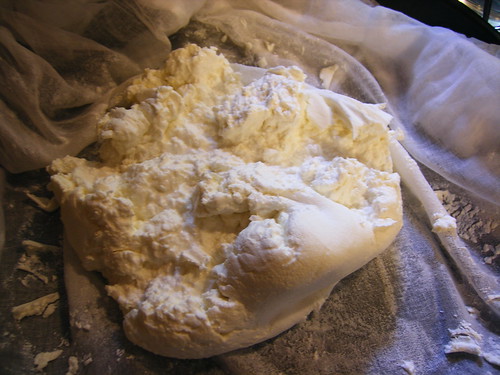
. . .
Sarah is going to write about our experience getting the goat milk and Nicole is going to do a writeup of the cheese we made with the group the next day. I also did a cheese and beer pairing with various goat cheeses including the fresh chevre we just made and I will write more about that.
Permalink






